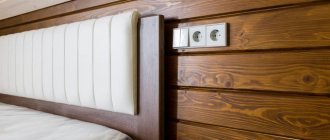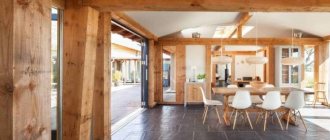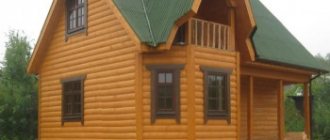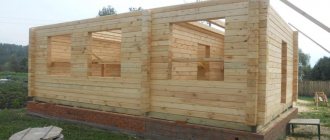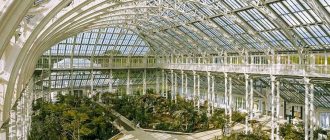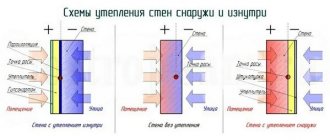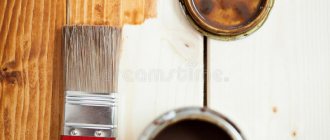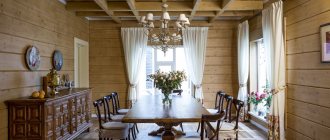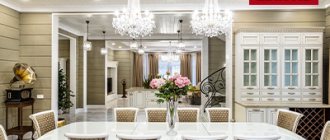No matter what new building materials appear, people will always build wooden houses. In all other houses you feel approximately the same as in a city apartment, but in a wooden cottage there is a special microclimate, which is why many choose country life.
Wooden houses have one disadvantage, but a big one - unprotected wood is not resistant to rain, wind, temperature changes and ultraviolet sunlight. Mold, mildew, cracking and changes in the geometry of wooden walls are familiar to anyone who has not taken care to protect them.
Raks04 FORUMHOUSE user
Untreated wood gets wet under precipitation and rots!
Fortunately, this drawback can be easily overcome: if a wooden structure is properly treated, it can last a hundred years or more. Wooden architectural monuments built in the 18th century, as a rule, were impregnated from the very beginning and then regularly treated with compounds based on natural tar.
Let’s figure out how to properly paint wooden houses together with TBM technical specialist Evgeniy Sevastyanov.
Features of the harmful effects of the environment
The outer surface of logs or beams is exposed to many destructive factors:
- Humidity. Under the influence of rain and snow, wood swells, cracks, loses strength and thermal insulation properties. Wood-boring beetles penetrate into cracks, dirt accumulates, and mold forms. Even on a smoothly planed surface, after repeated wetting, wood fibers rise, causing unsightly stains and stains. The walls take on a sloppy appearance. Various hydrophobic paints, oils and impregnations protect the surface from these troubles.
- Sunlight. Under its influence, the surface layer of wood changes color and then begins to collapse. At a minimum, the southern wall of the building should be additionally coated with photoresistent, light- and ultraviolet-resistant substances.
- Biogenic influences. Various insects, woodworms, fungus and mold can quickly destroy wooden walls. In this case, impregnation and paint are used that have insecticidal and antibacterial properties.
Untreated timber collapses, becomes moldy and looks unkempt Source rubankom.com
You will have to, if possible, take into account the totality of all harmful effects and, based on this, agree with the contractor on a list of all necessary work and materials. Only after discussing these issues can a final decision be made on how to paint the exterior of a timber house.
The external surfaces of a new building must be treated and painted no later than several months after completion of construction. Otherwise, they will quickly lose their aesthetically pleasing appearance. An exception is painting the outside of a house made of laminated veneer lumber; it can be done earlier, since this material does not shrink so much.
Stages of log processing: sequence and characteristics
If, after shrinkage of the log house, severe cracks and crevices appear in the wood, then treatment is carried out with special sealants.
Experts do not recommend carrying out work on processing a log house when its condition is considered damp and shrinkage has not occurred. An exception to this situation may be those surfaces of the log that, after installation, will be inaccessible and hidden in the structure of the log house.
In any other case, it is necessary to wait until the log house dries; its condition must correspond to the absence of natural moisture in it. This is due to the fact that excessive moisture content in building materials can make the penetration of the protective composition insufficient. As a result, you will not get the desired effect expected from their use.
The standard and most common type of treatment at the initial stage is the application of products whose action is aimed at protecting against fire. The next stage involves treatment with an antiseptic.
The action of fire retardants is due to the property that, upon contact with fire, allows the release of a special substance that prevents the flame from flaring up. Having carried out such treatment of the log house, you can be sure that if a situation arises when the wood is exposed to high temperatures, the fire-retardant properties will be activated, and the risk of fire will be reduced to a minimum.
As noted above, at the next stage, the log house of the bathhouse or house is treated, during which it is supposed to use an antiseptic. This type of processing is no less important than the previous one. It will allow very high quality protection of wooden blanks from the effects of bacterial infections and parasites.
As a result of this type of treatment, an atmosphere is created inside the tree that is not suitable for the life and reproduction of any insects. Fungus, bacteria and mold will also not be able to damage the structure you have built.
Varieties of painting compositions for exterior use
All materials for surface treatment can be divided into two main classes: impregnations and paints.
Impregnations
Impregnations are compounds that, when applied, penetrate deep enough into the wood. Their use allows you to solve several problems at once:
- Preparation for painting wood in a given color tone.
- Impregnation partially fills wood pores, cracks and surface unevenness. This will reduce the consumption of paint or varnish during their subsequent application, which saves money.
- Some types of paints have poor adhesion to wood. Preliminary application of impregnation strengthens the bond of paint with the surface being treated.
- Protection from insects, pests, mold and fungi.
Impregnation with an antiseptic will prevent the formation of mold and fungi Source build.4-u.info
- Giving wood fire-resistant properties.
- Reducing the harmful effects of the ultraviolet component of sunlight.
Each specific brand of impregnation has a set of necessary qualities. Therefore, it is necessary to discuss with the work performers the required parameters of the composition used and the expected amount of costs.
Paints and varnishes for exterior use
The main characteristics of paint and varnish coatings are type, color, service life. The service life of the paint is determined by its resistance to moisture, sunlight, and temperature changes.
If the wall surface looks good and has no roughness or defects, then it is best to use transparent or translucent varnishes or paints.
Such compositions include:
- Varnishes and paints based on polymer polyurethane. They have good resistance to external factors. Their high cost is explained by the durability and high strength of the coating.
- Water based paints. They are quite cheap, absorb and dry quickly. Unfortunately, without additional protection from water with a waterproofing layer, such paints quickly become stained, streaked, and sometimes simply washed away from the wall surface. It is preferable to use them for treating interior walls.
See also: Catalog of timber house projects presented at the Low-Rise Country exhibition.
A variety of shades of paints and varnishes allows you to choose a composition to suit every taste Source build.4-u.info
Old, and sometimes new walls, have defects, stains, cracks. Making such a surface uniform in texture is difficult and expensive. In this situation, it is necessary to use opaque paints. In this case, you will be faced with the question: what color to paint the pulp from the timber - the choice of colors and textures is very large.
- Oil paints. Due to their low cost and availability, they are still popular. The main disadvantage is that after 2–3 years such paint cracks and fades. Walls that have lost their attractiveness will have to be repainted.
- Alkyd-based compositions are less susceptible to fading. Alkyd paints are available in a wide range of colors. The main problem is low weather resistance.
- Acrylic paint coatings will last longer than alkyd or oil paints. Manufacturers offer a large number of colors and shades of this type of paint. Acrylic paint for external beams has a higher price, but this is more than compensated by the greater strength and durability of the coating.
A separate type of materials for processing are sealants and paint for the ends of the timber. It is not advisable to replace them with other compounds.
The most effective means for treating the outside of your home
For those who are interested in how to treat timber, how to cover imitation timber, how to protect a timber and log house from insects, mold, rot and fire, we have compiled a list of the most popular and effective products that are suitable for external treatment.
"Senezh". The domestic manufacturer produces tinting and preservative antiseptics based on acrylate and water, bleaches and fire-retardant compounds. Under the Senezh brand, more than twenty types of hard-to-rinse products are produced for treating the facade and bottom of a log house, providing protection for wood for more than ten years.
"Belinka". This brand offers a wide range of protective products that protect wood from moisture, insects, UV radiation and fire.
"Pinotex". Polymer-based products are perfect for internal and external processing of timber, including imitation timber. The products are resistant to large temperature changes and protect the simulated timber from moisture, fungus, and microorganisms.
"Neomid". Antiseptics for external use, protecting wood from biological damage for 6-7 years. The manufacturer also produces fire retardant compounds, wax impregnations, bath oil, and special products for processing ends.
"Tikkurila". The Finnish company produces moisture-resistant preparations that create a protective film on the surface. External wooden surfaces treated with these compounds receive good protection from various atmospheric conditions.
"Aquatex". Inexpensive primers and impregnations made in Russia protect the outer walls of the log house from fungus, moisture and ultraviolet radiation. Available in clear and tinted forms, there are fifteen options in different colors on the market.
carries out all types of work on the territory of Moscow and the Moscow region for finishing a wooden house. The processing of the façade of the log house is carried out by our craftsmen strictly according to technology, taking into account the peculiarities of the structure. All materials we use have the necessary certificates.
You can ask questions, send your application and call a specialist to draw up an estimate using the coordinates located in the “Contacts” section.
If you require legal advice , we can advise you. These are our partners with whom we have been working for several years and trust them to resolve all legal issues.
Calculate the cost of painting and insulating your home right now
Select types of work:
Select materials:
Main stages of painting
Knowing how to paint a house made of timber from the outside and the technological sequence of operations will allow you to properly control the entire process.
The quality of painting a wooden house depends on adherence to technology at all stages of the work Source stroi-archive.ru
See also: Catalog of companies that specialize in finishing materials.
Preparing for painting
The surface of the timber must be cleaned of dirt or remnants of old paint.
Using plows, scrapers, electric planes, remove significant unevenness, roughness, resin streaks or layers of old paint. The use of a metal brush allows you to achieve good results and high productivity.
Large cracks, holes from knots and wood pests are carefully puttied. You can proceed to grinding and polishing only after the putty has completely set and hardened.
Sanding wood. This operation is performed using a grinding machine in several stages. First use coarse sandpaper. For final sanding, the sandpaper grain is reduced.
Polishing will smooth out the fibers remaining after sanding and give the surface a gloss.
Be sure to check whether the ends have been sanded and treated with mastic. This will prevent cracking and moisture penetration into the most vulnerable area of the timber.
Sanding is an important preparation step before painting the house Source doka-metal.ru
Such work generates a large amount of dust.
Important! Before applying impregnating and painting solutions, settled dust and dirt must be removed.
The surface can be cleaned with compressed air or special cleaning compounds. Please note that the use of detergents will wet the surface of the walls. Before applying impregnation, you must wait several days until they are completely dry.
Impregnation and painting
Do not insist on carrying out work during rain and fog. Wet wood swells and does not absorb paint well, which leads to peeling and cracks in the coating.
Do not paint external surfaces at sub-zero temperatures. A test inspection should be carried out before the main painting. Ask to paint a small area of the surface and make sure you are happy with the result. The examples of painting wooden houses in the photo are one thing, but it’s worth seeing how the paint applies to the wood of your house.
The choice of methods for applying the compositions remains with the performer:
- Painting by hand. The work is carried out using a paint brush. If the wall is smooth, then you can use a paint roller. This method will provide the best quality surface treatment, but will require a significant investment of time and effort.
Painting using a spray gun reduces material consumption Source paint.xkm.ru
How to prepare wood
It is impossible to create a long-term coating without following all the regulations for exterior finishing work recommended by the manufacturer. But many homeowners find it excessive to control the moisture content of the wood, select a good brush, and sand the surface. There is a common myth that if the paint is of high quality, then there is no need to prepare the wood for painting.
As one of our participants wrote, “people want to spray the log house with a garden sprayer in two hours and go barbecue. Perhaps someday this will be the case, but at the moment such paintwork does not exist.”
The quality of painting a house directly depends on the degree of preparation of the wooden surface!
Before painting, the surface must be clean and dry, all stains of resin must be removed with a clean rag and solvent. You can’t do this without grinding, no matter how labor-intensive this process may seem.
Painting a house made of profiled or laminated timber
Profiled and laminated timber has a high cost, which is due to the complexity of its manufacture and good quality. Therefore, painting the outside of a log house made from such materials has some peculiarities.
The grinding and polishing stages are less labor-intensive due to the initially smooth surface of this type of timber.
Treatment with an antiseptic should be performed as quickly as possible. Otherwise, the outer layer may change color due to fungus, mold or exposure to sunlight.
It is best to coat the timber with impregnation during the construction process. It is advisable to apply an antiseptic and fire-resistant impregnation before laying the timber in the log house.
Applying primer is a mandatory operation when working with laminated veneer lumber. Paint or varnish binds more firmly to a primed surface.
It is advisable to paint a house made of laminated timber with varnish, oil or acrylic paints. Water-based colors cannot be used, as laminated veneer lumber does not absorb water well, and stains and stains may appear.
conclusions
- Long-term and beautiful wood coating is only possible on properly prepared wood.
- If you do not want to hide the structure of the wood, choose covering paints.
- The product used for antiseptic must be combined with varnish, paint or oil. Do not apply paints based on natural oils to compounds that form a polymer film, or oils to water-based antiseptics.
- Antiseptics, azures and oils are most often applied with brushes (dense packing is important, wax must be natural or mixed).
- The most important condition is to follow all the manufacturer’s recommendations for the formation of paintwork.
At FORUMHOUSE all the nuances of processing and painting a wooden house are discussed, join the discussion.
Cost of work and paintwork
The price of painting a house depends on many factors: the quality of the surface, the timing and volume of work.
Cost of processing 1 sq. m. surface when performing basic operations:
- surface grinding – from 50 to 100 rubles;
- application of antiseptic – from 50 to 80 rubles;
- processing of ends (grinding, priming, painting) – about 250–300 rubles;
- varnishing (one layer) – from 100 to 150 rubles;
- painting with oil paint – from 100 to 200 rubles;
- oil impregnation – 100 rubles.
You can calculate the full cost of the work after agreeing with the contractor on all stages and materials Source market.sakh.com
If the choice of coating color is determined by the owner of the house, then the quality and type of impregnations and paints and varnishes should be discussed with experienced professionals.
An easily understandable desire to save money by buying cheap paint can result in large expenses in 2-3 years. A cheap coating quickly begins to peel off, crack, and quickly fade.
The lower price threshold for paints is 100–150 rubles per liter. Service life – up to 3 years.
High-quality paints and varnishes have a price of 300 rubles or more. They retain their properties for 5–6 years.
It must be taken into account that a low price, all other things being equal, means a shorter service life of the coating, and, therefore, additional costs for a new repainting of the facade.
Is it necessary to treat imitation timber with a fire retardant?
Statistics say that a large number of fires in the private sector occur due to fires of cottages from the facade (burning grass, welding work, etc.). It is clear that it would be better to somehow reduce the flammability of wooden planks of imitation timber.
Fortunately, we do not need to purchase any special materials for this and do not need to do double work to protect the wood. This became possible thanks to the availability on sale of complex multicomponent compositions that can work as an antiseptic and at the same time as a fire retardant. A striking example of such universal products can be the line of biopyrenes from the NORT company. You can choose from the following list:
This manufacturer has a unique complex, which consists of the fire retardant “Pirilax”-K45 and the protective and decorative composition “Krasula”. In general, it is worth noting that when combining substances in complexes and complex compositions, a synergy effect is often observed - that is, a mutual enhancement of the unique working properties of each component.
Additional recommendations
At the last stage of processing a log house made from rounded logs, if there is such a need, the wood is protected with the help of a preservative. Quite often you can find protective compounds that, along with others, already include preservative substances.
The final decorative treatment allows for various variations and is limited only by the imagination of the owners.
But there are also separate products presented exclusively for carrying out procedures aimed at conservation. This treatment will allow the tree to retain all its positive qualities for a long period. It will also help protect against various natural phenomena, such as precipitation, exposure to ultraviolet rays (sun), as well as lower temperatures.
Such treatment can also be carried out for the purpose of prevention; it must be done quite regularly. Only in this case will you be able to achieve a high-quality result, and the log house made of rounded logs used for construction will retain its aesthetic appearance, strength and reliability for decades.
In conclusion, it is necessary to recall the decorative method of processing.
The application of this type of coating, which seemingly does not perform any other functions other than giving the house an aesthetic appearance, can also be regarded as protective. As a result of this processing, you get an emphasized texture of the building material, a pleasant color scheme, and as an addition, the formation of a protective film.
Typically, either varnish or special paint is used for these purposes. The degree of moisture penetration after this treatment is reduced several times, which, in turn, has a positive effect on the service life of the constructed house or bathhouse.
What characteristics of painting materials should you pay attention to?
- Possibility to use outdoors.
- Can be used indoors (environmentally safe).
- How it holds high temperatures (relevant for steam rooms).
- Does it provide protection against fire and biological damage?
- What materials does it combine with?
- How many layers should be applied?
- How long does it take to renew the coating?
- What kind of materials is the product designed to process (permissible moisture content of the lumber, is there any damage or is our surface completely healthy...).
- Does it form a film (glossy, matte surface...).
- Does the level of vapor permeability of wood change?
- Is there a coloring effect, can it be tinted?
- How long does it take for the layer to dry, at what temperatures can it be applied.
- What application methods are acceptable?
Imitation timber in the form of profiled or planed boards is an excellent material that is suitable for finishing houses both outside and inside. However, after installation, the material needs protective impregnation, created on the basis of special compounds with membrane properties.
This coating will protect the wood from the adverse effects of moisture, microorganisms and various harmful insects that destroy the wood. For this purpose, imitation timber is painted. In addition, this procedure is done in order to transform the appearance of a room or home.
